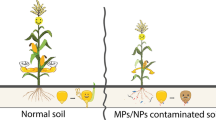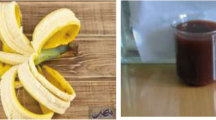Abstract
Nowadays, nanotechnology is one of the most dynamically developing and most promising technologies. However, the safety issues of using metal nanoparticles, their environmental impact on soil and plants are poorly understood. These studies are especially important in terms of copper-based nanomaterials because they are widely used in agriculture. Concerning that, it is important to study the mechanism behind the mode of CuO nanoparticles action at the ultrastructural intracellular level. It is established that the contamination with CuO has had a negative influence on the development of spring barley. A greater toxic effect has been exerted by the introduction of CuO nanoparticles as compared to the macrodispersed form. A comparative analysis of the toxic effects of copper oxides and nano-oxides on plants has shown changes in the tissue and intracellular levels in the barley roots. However, qualitative changes in plant leaves have not practically been observed. In general, conclusions can be made that copper oxide in nano-dispersed form penetrates better from the soil into the plant and can accumulate in large quantities in it.






Similar content being viewed by others
References
Anjum, N. A., Gill, S. S., Duarte, A. C., et al. (2013). Silver nanoparticles in soil–plant systems. Journal of Nanoparticle Research, 15, 1–26. https://doi.org/10.1007/s11051-013-1896-7.
Arendt, E. K., & Zannini, E. (2013). Cereal grains for the food and beverage industries (p. 512). Amsterdam: Woodhead Publishing Limited.
Assadian, E., Zarei, M. H., Gilani, A. G., et al. (2017). Toxicity of copper oxide (CuO) nanoparticles on human blood lymphocytes. Biological Trace Element Research, 184(2), 350–357. https://doi.org/10.1007/s12011-019-01678-7.
Bauer, T., Pinskii, D., Minkina, T., Nevidomskaya, D., Mandzhieva, S., Burachevskaya, M., et al. (2018). Time effect on the stabilization of technogenic copper compounds in solid phases of Haplic Chernozem. Science of the Total Environment, 626, 1100–1107.
Conway, J. R., Hanna, S. K., Lenihan, H. S., & Keller, A. A. (2014). Effects and implications of trophic transfer and accumulation of CeO2 nanoparticles in a marine mussel. Environmental Science and Technology, 48, 1517–1524. https://doi.org/10.1021/es404549u.
Costa, D. M. V. J., & Sharma, P. K. (2016). Effect of copper oxide nanoparticles on growth, morphology, photosynthesis, and antioxidant response in Oryza sativa. Photosynthetica, 54, 110. https://doi.org/10.1007/s11099-015-0167-5.
Darlington, T. K., Neigh, A. M., Spencer, M. T., Nguyen, O. T., & Oldenburg, S. J. (2009). Nanoparticle characteristics affecting environmental fate and transport through soil. Environmental Toxicology and Chemistry, 28(6), 1191–1199.
Dmitrakov, L. M., & Dmitrakova, L. К. (2006). Lead translocation in oat plants. Agrochemistry, 2, 71–77. (in Russian).
Du, W., Tan, W., Yin, Y., Ji, R., Peralta-Videa, J. R., Guo, H., et al. (2018). Differential effects of copper nanoparticles/microparticles in agronomic and physiological parameters of oregano (Origanum vulgare). Science of the Total Environment, 618, 306–312.
Fedorenko, G. M., Fedorenko, A. G., Minkina, T. M., et al. (2018). Method for hydrophytic plant sample preparation for light and electron microscopy (studies on Phragmites australis Cav.). MethodsX, 5, 1213–1220. https://doi.org/10.1016/j.mex.2018.09.009.
Festa, R. A., & Thiele, D. J. (2011). Copper: an essential metal in biology. Current Biology, 21, 877–883. https://doi.org/10.1016/j.cub.2011.09.040.
Gabbay, J., Borkow, G., Mishal, J., Magen, E., Zatcoff, R., & Shemer-Avni, Y. (2006). Copper oxide impregnated textiles with potent biocidal activities. Journal of Industrial Textiles, 35, 323–335. https://doi.org/10.1177/1528083706060785.
Gomes, T., Pinheiro, J. P., Cancio, I., et al. (2011). Effects of copper nanoparticles exposure in the mussel Mytilus galloprovincialis. Environmental Science and Technology, 45, 9356–9362. https://doi.org/10.1021/es200955s.
Griffitt, R. J., Hyndman, K., Denslow, N. D., & Barber, D. S. (2009). Comparison of molecular and histological changes in zebrafish gills exposed to metallic nanoparticles. Toxicological Sciences, 107(2), 404–415. https://doi.org/10.1093/toxsci/kfn256.
Gunawan, C., Teoh, W. Y., Marquis, C. P., & Amal, R. (2011). Cytotoxic origin of copper (II) oxide nanoparticles: comparative studies with micron-sized particles, leachate, and metal salts. ACS Nano, 5, 7214–7225. https://doi.org/10.1021/nn2020248.
Guzman, K. A., Finnegan, M. P., & Banfield, J. F. (2006). Influence of surface potential on aggregation and transport of titania nanoparticles. Environmental Science and Technology, 40(24), 7688–7693.
Hänsch, R., & Mendel, R. R. (2009). Physiological functions of mineral micronutrients (Cu, Zn, Mn, Fe, Ni, Mo, B, Cl). Current Opinion in Plant Biology, 12(3), 259–266. https://doi.org/10.1016/j.pbi.2009.05.006.
Hartwig, A. (2013). Metal interaction with redox regulation: an integrating concept in metal carcinogenesis? Free Radical Biology and Medicine, 55, 63–72. https://doi.org/10.1016/j.freeradbiomed.2012.11.009.
Hou, J., Wang, X., Hayat, T., & Wang, X. (2017). Ecotoxicological effects and mechanism of CuO nanoparticles to individual organisms. Environmental Pollution, 221, 209–217.
Hu, W., Culloty, S., Darmody, G., et al. (2014). Toxicity of copper oxide nanoparticles in the blue mussel, Mytilus edulis: A redox proteomic investigation. Chemosphere, 108, 289–299. https://doi.org/10.1016/j.chemosphere.2014.01.054.
Ivask, A., Bondarenko, O., Jepihhina, N., & Kahru, A. (2010). Profiling of the reactive oxygen species related eco-toxicity of CuO, ZnO, TiO2, silver and fullerene nanoparticles using a set of recombinant luminescent Escherichia coli strains: differentiating the impact of particles and solubilised metals. Analytical and Bioanalytical Chemistry, 398, 701–716. https://doi.org/10.1007/s00216-010-3962-7.
Julich, D., & Gäth, S. (2014). Sorption behavior of copper nanoparticles in soils compared to copper ions. Geoderma, 235–236, 127–132. https://doi.org/10.1016/j.geoderma.2014.07.003.
Kahru, A., & Ivask, A. (2013). Mapping the dawn of nanoecotoxicological research. Accounts of Chemical Research, 46(3), 823–833. https://doi.org/10.1021/ar3000212.
Keller, A., McFerran, S., Lazareva, A., et al. (2013). Global life cycle releases of engineered nanomaterials. Journal of Nanoparticle Research, 15, 1692. https://doi.org/10.1007/s11051-013-1692-4.
Krzesłowska, M., Lenartowska, M., Samardakiewicz, S., Bilski, H., & Woźny, A. (2010). Lead deposited in the cell wall of Funaria hygrometrica protonemata is not stable-a remobilization can occur. Current Opinion in Plant Biology, 158, 325–338.
Kulizhsky, S., Loyko, S., & Lim, A. (2013). Pedotransfer capacity of nickel and platinum nanoparticles in Albeluvisols Haplic in the South-East of the Western Siberia. Eurasian J. Soil Sci., 2(2), 90–96.
Kvesitadze, G. I., Khatisashvili, G. A., Sadunishvili, T. A., & Evstigeneeva, Z. G. (2005). Metabolism of anthropogenic toxicants in higher plants (p. 199). Moscow: Publishing House Science. (in Russian).
Lecoanet, H. F., Bottero, J.-Y., & Wiesner, M. R. (2004). Laboratory assessment of the mobility of nanomaterials in porous media. Environmental Science and Technology, 38(19), 5164–5169.
Ma, X., Geiser-Lee, J., Deng, Y., & Kolmakov, A. (2010). Interactions between engineered nanoparticles (ENPs) and plants: phytotoxicity, uptake and accumulation. Science of the Total Environment, 408(16), 3053–3061. https://doi.org/10.1016/j.scitotenv.2010.03.031.
MacFarlane, G. R., & Burchett, M. D. (2000). Cellular distribution of copper, lead and zinc in the grey mangrove, Avicennia marina (Forsk.) Vierh. Aquatic Botany, 68, 45–59.
McVay, I. R., Maher, W. A., Krikowa, F., & Ubrhien, R. (2019). Metal concentrations in waters, sediments and biota of the far south-east coast of New South Wales, Australia, with an emphasis on Sn, Cu and Zn used as marine antifoulant agents. Environmental Geochemistry and Health, 41, 1351–1367.
Minkina, T. M., Fedorov, Y. A., Nevidomskaya, D. G., Pol’shina, T. N., Mandzhieva, S. S., & Chaplygin, V. A. (2017). Heavy metals in soils and plants of the don river estuary and the Taganrog Bay coast. Eurasian Soil Science, 50(9), 1033–1047. https://doi.org/10.1134/S1064229317070067.
Minkina, T., Rajput, V., Fedorenko, G., Fedorenko, A., Mandzhieva, S., Sushkova, S., et al. (2019). Anatomical and ultrastructural responses of Hordeum sativum to the soil spiked by copper. Environmental Geochemistry and Health. https://doi.org/10.1007/s10653-019-00269-8.
Morgalev, Yu N, Khoch, N. S., Morgaleva, T. G., et al. (2010). Biological testing of nanomaterials: on the possibility of nanoparticles translocation into food networks. Russian Nanotechnologies, 5, 131–135. https://doi.org/10.1134/S1995078010110157.
Musante, C., & White, J. C. (2012). Toxicity of silver and copper to Cucurbita pepo: Differential effects of nano and bulk-size particles. Environmental Toxicology, 27, 510–517.
Navratilova, J., Praetorius, A., Gondikas, A., Fabienke, W., von der Kammer, F., & Hofmann, T. (2015). Detection of engineered copper nanoparticles in soil using single particle ICP-MS. International Journal of Environmental Research and Public Health, 12(12), 15756–15768. https://doi.org/10.3390/ijerph121215020.
Nishizono, H., Ichikawa, H., Suziki, S., & Ishii, F. (1987). The role of the root cell wall in the heavy metal tolerance of Athyrium yokoscense. Plant and Soil, 101, 15–20.
Oberdörster, G., Stone, V., & Donaldson, K. (2007). Toxicology of nanoparticles: A historical perspective. Nanotoxicology, 1, 2–25. https://doi.org/10.1080/17435390701314761.
Ouzounidou, G., Eleftheriou, E., & Karataglis, S. (1992). Ecophysiological and ultrastructural effects of copper in Thlaspi ochroleucum (Cruciferae). Canadian Journal of Botany, 70, 947–957.
Panou-Filotheou, H., Bosabalidis, A. M., & Karataglis, S. (2001). Effects of copper toxicity on leaves of oregano (Origanum vulgare subsp. hirtum). Annals of Botany, 88, 207–214. https://doi.org/10.1006/anbo.2001.1441.
Peng, C., Duan, D. C., Xu, C., et al. (2015). Translocation and biotransformation of CuO nanoparticles in rice (Oryza sativa L.) plants. Environmental Pollution, 197, 99–107. https://doi.org/10.1016/j.envpol.2014.12.008.
Perevolotskaya, T. V., & Anisimov, V. S. (2018). Conceptual and mathematical statement of the process of heavy metals migration in the system soil–agricultural plant. Biogeosystem Technique, 5(1), 110–128. https://doi.org/10.13187/bgt.2018.1.110.
Phenrat, T., Kim, H.-J., Fagerlund, F., Illangasekare, T., Tilton, R. D., & Lowry, G. V. (2009). Particle size distribution, concentration, and magnetic attraction affect transport of polymer-modified Fe0 nanoparticles in sand columns. Environmental Science and Technology, 43(13), 5079–5085.
Rajput, V., Minkina, T., Ahmed, B., Sushkova, S., Singh, R., Soldatov, M., et al. (2020). Interaction of copper-based nanoparticles to soil, terrestrial, and aquatic systems: Critical review of the state of the science and future perspectives. Reviews of Environmental Contamination and Toxicology, 252, 51–96. https://doi.org/10.1007/398_2019_34.
Rajput, V., Minkina, T., Sushkova, S., Behal, A., Maksimov, A., Blicharska, E., et al. (2019). ZnO and CuO nanoparticles: A threat to soil organisms, plants, and human health. Environmental Geochemistry and Health. https://doi.org/10.1007/s10653-019-00317-3.
Rajput, V., Minkina, T. M., Fedorenko, A. G., et al. (2018a). Toxicity of copper oxide nanoparticles on spring barley (Hordeum sativum distichum). Science of the Total Environment, 645, 1103–1113. https://doi.org/10.1016/j.scitotenv.2018.07.211.
Rajput, V. D., Minkina, T., Suskova, S., et al. (2018b). Effects of copper nanoparticles (CuO NPs) on crop plants: A mini review. BioNanoSci, 8, 36–42. https://doi.org/10.1007/s12668-017-0466-3.
Rico, C. M., Majumdar, S., Duarte-Gardea, M., Peralta-Videa, J. R., & Gardea-Torresdey, J. L. (2011). Interaction of nanoparticles with edible plants and their possible implications in the food chain. Journal of Agriculture and Food Chemistry, 59, 3485–3498. https://doi.org/10.1021/jf104517j.
Shaw, A. K., & Hossain, Z. (2013). Impact of nano-CuO stress on rice (Oryza sativa L.) seedlings. Chemosphere, 93, 906–915. https://doi.org/10.1016/j.chemosphere.2013.05.044.
Tutayuk, V. H. (1972). Anatomy and morphology of plants. Textbook for agricultural universities (p. 336). Moscow: Higher School Publishing House. (in Russian).
Usatov, A. V., Fedorenko, G. M., Shcherbakova, L. B., & Mashkina, E. V. (2004). Ultrastructure of chloroplasts in mustard Brassica juncea as an index of salt tolerance. Tsitologiya, 46, 1035–1042.
Vesk, P. A., Nockolds, C. E., & Allaway, W. G. (1999). Metal localization in water hyacinth roots from an urban wetland. Plant, Cell and Environment, 22, 149–158.
Xiong, T., Dumat, C., Dappe, V., Vezin, H., Schreck, E., Shahid, M., et al. (2017). Copper oxide nanoparticle foliar uptake, phytotoxicity, and consequences for sustainable urban agriculture. Environmental Science and Technology, 51, 5242–5251.
Ytterberg, A. J., Peltier, J. B., & van Wijk, K. J. (2006). Protein profiling of plastoglobules in chloroplasts and chromoplasts. A surprising site for differential accumulation of metabolic enzymes. Plant Physiology, 140, 984–997.
Zhang, N., He, X. D., Gao, Y. B., Li, Y. H., Wang, H. T., Ma, D., et al. (2010). Pedogenic carbonate and soil dehydrogenase activity in response to soil organic matter in Artemisia ordosica community. Pedosphere, 20, 229–235. https://doi.org/10.1016/s1002-0160(10)60010-0.
Zuverza-Mena, N., Medina-Velo, I. A., Barrios, A. C., Tan, W., Peralta-Videa, J. R., & Gardea-Torresdey, J. L. (2015). Copper nanoparticles/compounds impact agronomic and physiological parameters in cilantro (Coriandrum sativum). Environmental Science: Processes & Impacts, 17, 1783–1793. https://doi.org/10.1039/c5em00329f.
Acknowledgements
This research was supported by the Russian Scientific Foundation, No. 19-74-10046. Analytical work was carried out on the equipment of Centers for collective use of Southern Federal University “Modern microscopy” and “High Technology.”
Author information
Authors and Affiliations
Corresponding author
Additional information
Publisher's Note
Springer Nature remains neutral with regard to jurisdictional claims in published maps and institutional affiliations.
Rights and permissions
About this article
Cite this article
Fedorenko, A.G., Minkina, T.M., Chernikova, N.P. et al. The toxic effect of CuO of different dispersion degrees on the structure and ultrastructure of spring barley cells (Hordeum sativum distichum). Environ Geochem Health 43, 1673–1687 (2021). https://doi.org/10.1007/s10653-020-00530-5
Received:
Accepted:
Published:
Issue Date:
DOI: https://doi.org/10.1007/s10653-020-00530-5




